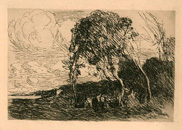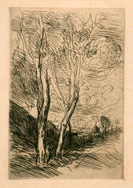
|
P. 160x240mm, S.
265x396mm
|
Souvenir des
Fortifications de Douai
Robaut 3134,
Delteil 12, Melot 12
etching, circa 1869-70,
on medium-fine cream fibrous Japon ancien* paper with wirelines,
the 1st (and only) state, a superb and crisp impression with wide
margins, one of the rare lifetime proofs before the sole 1908 edition,
printed with plate tone, selectively darkening the foreground and
leaving bright highlights, the plate edges wiped clean, signed and
dedicated in pencil, "en Souvenir du Maître, à mon ami Eugène
Ducasse" by Alfred Robaut, and further annotated by Robaut, "Eau-forte
de Corot (des dernières années)"; traces of two hinges from an old
mount on the reverse, otherwise in excellent condition
 
|
Provenance: the Henri
M. Petiet collection, with the HMP wetstamp on the reverse
(not cited in Lugt), and formerly the Eugène Ducasse
collection (as shown by the dedication)
|
Le Dôme Florentin
Robaut 3135,
Delteil 13, Melot 13
etching, circa 1869-70,
on medium-fine cream fibrous Japon ancien* paper with wirelines,
the 1st state (of 3), a superb and crisp impression with wide margins,
one of the very rare lifetime proofs before the posthumous 1908
edition, printed with selective plate tone, the plate edges wiped
clean, signed and dedicated in pencil "en Souvenir du Cher Maître,
à mon ami Eug. Ducasse" by Alfred Robaut; a few slight foxmarks,
mostly in the margins, and traces of two hinges from an old mount on
the reverse, otherwise in excellent condition (as shown by the dedication)
P. 240x160mm., S.
390x267mm.

|
Provenance: a private
French collection, and formerly the Eugène Ducasse collection
These exquisite etchings,
Corot's last, are also to be counted among his most important
(cf. Roger Passeron 1974**, who, noting the extreme freedom of
line, considers Le Dôme Florentin to be a masterpiece).
They were furthermore never published during the artist's lifetime,
and thus such early proofs are most exceptional, the result of
a rather curious history.
According to Alfred Robaut,
these two plates (along with one other) were put aside by Corot
after having completed the drawing in the varnish ground, yet
before etching, and were subsequently mislaid for several years.
They were rediscovered in the winter of 1872 by the artist, and
given to Robaut, who relates (his unpublished notes, in Delteil):
"On 6 June 73, I went to
Salmon's shop to run trials of this plate and the two that follow [i.e.
Delteil 12 and 13]. I had him print two impressions on laid paper -
from Holland - and five impressions on Chine volant. It was Mr Alf.
Delaunay who etched the plates... On 14 November 73, at Cadart's shop,
I had two impressions of each plate pulled on Japon." ***
In his catalogue raisonné,
the first such work devoted to Corot, Robaut further gives these
prints a "RRR" rating, i.e. extremely rare, specifying
"quelques épreuves d'essai seulement."
Delteil however records some twenty proofs pulled between 1873
and 1890, supposing a certain number of later impressions between
Corot's death and the sale of the plate in 1908.
Eugène Ducasse
was one of Corot's students, and his collection of the master's
prints comprised some of the finest impressions known (for other
rare works from this collection, see the Ader Picard Tajan sales
at Drouot, 22/2/1984, #73 and 26/10/1988, #30). Given the dedication,
it seems clear that the present proofs were offered to Ducasse
by Robaut at the time of Corot's death in 1874, and thus correspond
to one of the rare lifetime trial proofs printed by Robaut.
* This paper is identical
to that of one of the two early proofs of the Dôme Florentin
now in the Bibliothèque Nationale (from the Moreau-Nelaton
collection, and, formerly, that of Alfred Robaut). Sometimes mistakenly
identified as "Chine volant" (cf. the 1991 BN catalogue
of the Moreau-Nelaton donation, and that of the 1931 Corot exhibition)
because of its fineness, whitish colour, and matte aspect, it
contrasts with the heavier weight, the cream-yellow colour, and
the satiny aspect of the Japon paper of the other proof.
Thus there are two varieties
of Japon in the early proofs, and although Cadart may have used
such different papers, the two BN impressions are not printed
in the same manner, the first being sharper and more contrasted,
the second more heavily inked.
Furthermore, there are
known early impressions of these prints on Chine volant properly
speaking: the sole proof in the BN of the first plate of this
series (Delteil 11, also from the Robaut collection), and the
impressions of Delteil 12 and Delteil 13 from the Samuel Avery
collection in the NYPL.
It is thus specifically
difficult to identify the Cadart impressions. Whatever conclusions
may be drawn, it remains that these impressions were considered
to be choice proofs by Robaut himself, as witnessed by their presence
in his own collection and his moving dedication to Eugène
Ducasse.
** Roger Passeron, La
Gravure Impressionniste 1974; see also the RMN/BN exhibition
catalogue De Corot aux Impressionistes, donations Moreau-Nélaton,
1991, and the BN exhibition catalogue Corot, le Génie
du Trait, 1996.
*** "Le 6 juin
73 je fais faire chez Salmon l'essai de cette planche et des deux
qui suivent. J'en fais tirer de chaque 2 épreuves sur papier
à la forme - de hollande - et 5 épreuves sur chine
volant. C'est M. Delaunay Alf. qui a fait mordre les planches...
Le 14 novembre 73 j'en ai fait tirer chez Cadart 2 épreuves
de chaque sur japon."





